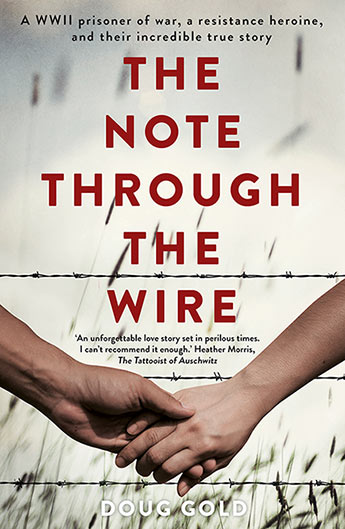After enlisting in 1940, Bruce Murray, an unhappily married 24-year-old, was posted to the 25th Battalion, 2nd New Zealand Expeditionary Force.

Paperback 336pp RRP $29.99
On Anzac Day 1941, as Greece fell to the Germans, he was wounded and became separated from his battalion colleagues as they attempted to withdrew to Kalamata Bay. After capture he was hospitalised in Corinth before beginning the several ‘cattle train’ journeys to Stalag XVIIID in Maribor, Slovenia. His parents were officially notified that he was ‘missing in action’ on 18th May.
Josefine Lobnik, an 18-year-old German-speaking native of Maribor, Slovenia, had joined the local partisans in December 1941. The Germans seized her brother on 2nd February 1942. Posing as an elderly woman on a walking stick, on 15th February she sought information of her brother’s whereabouts from the Allied inmates of Stalag XVIIID, whose compound abutted where the East European prisoners were kept.
Unable to mutually communicate, Josefine passed a note to Bruce through the wire. She was fired on by guards and badly wrenched her knee in making her way to safety. Bruce returned weekly to the wire, but Josefine did not return. On 8th April he passed a note for ‘the young lady posing as an old woman’ back to the partisans indicating that he had been unable to gain no information for her.
A recalcitrant prisoner, Bruce was hospitalised having been beaten after attacking a German guard in September 1942. He was then moved around until he being assigned to a work camp in Radkersburg, south-east Austria to work on Rossnegger’s farm. Josefine, as a partisan, was betrayed to the Germans in Maribor by her best friend, and knowing she was on a Nazi death list, fled to (her cousin) Rossnegger’s farm in Austria. On 3rd March 1943, Bruce’s 27th birthday, he and Josefine caught up again for the first time since their initial encounter.
Bruce found a loose bar in his hut and spent numerous nights with Josefine listening to BBC broadcasts on a clandestine radio in a neighbouring farm. Josefine, continued acting as a partisan courier of stolen papers, maps, plans and small weapons. She returned to Maribor from August to December 1943, before returning again to Radkersburg. Josefine commenced delivering Red Cross parcels from Bruce’s camp colleagues to local partisans, and by June 1944, she and Bruce had combined to make six such deliveries. A twice-decorated heroine, she escorted a group of six POW escapees to safety in August 1944. In the largest successful rescue effort of the War, a total 99 of 105 escapees from railway work parties survived to be airlifted to Italy on 17th September.
By 4th April 1945, the Russians had commenced shelling Radkersburg. Knowing that the Germans would force march them large distances to other camps, Bruce and his mate escaped the camp.
Promising to come return for her and in suits Josefine had acquired, they surrendered to the Russians – only to have to briefly fight along their troops. The Russians, over a fortnight, moved the prisoners by rail to Odessa in the Ukraine so they could then be shipped to Naples. Bruce unsuccessfully tried everything to get back to Slovenia rather than be shipped back to New Zealand.
Bruce was aware, from Josefine’s letters, that she had received none of his own, but persisted in continuing the one-sided correspondence. Discharged from the Army on 6 March 1946 and now divorced, it took Bruce five months to gain a berth on a ship to Europe. Josefine had a visa to the UK by December of that year, but it was another year before they were united and finally married on 27th December 1947 in Cleethorpes, Lancashire. They returned to New Zealand and raised three children.
Doug Gold, being the suitor of the eldest daughter Anemarie, realised there was a fascinating story behind his future in-laws. Bruce eventually opened up to Doug (who had no intent to do more than record their wartime activities) but died in 1993. Convincing Josefine to tell her story five years later, Doug arranged to meet her in France. Three days prior to that meeting, a car accident resulted in Josefine’s death. Writing was then stalled for 20 years, but preservation of the story for his own descendants became the primary goal.
This remarkable story makes for fascinating reading, and one can sense Gold’s absolute admiration for the hardships, trials and risks that confronted these two heroes over 70 years ago.
Reviewed for RUSIV by Neville Taylor, March 2020
Contact Royal United Services Institute about this article.






